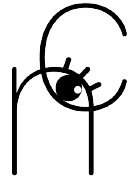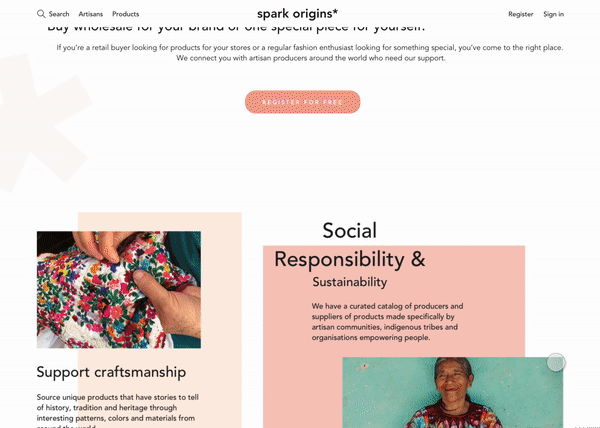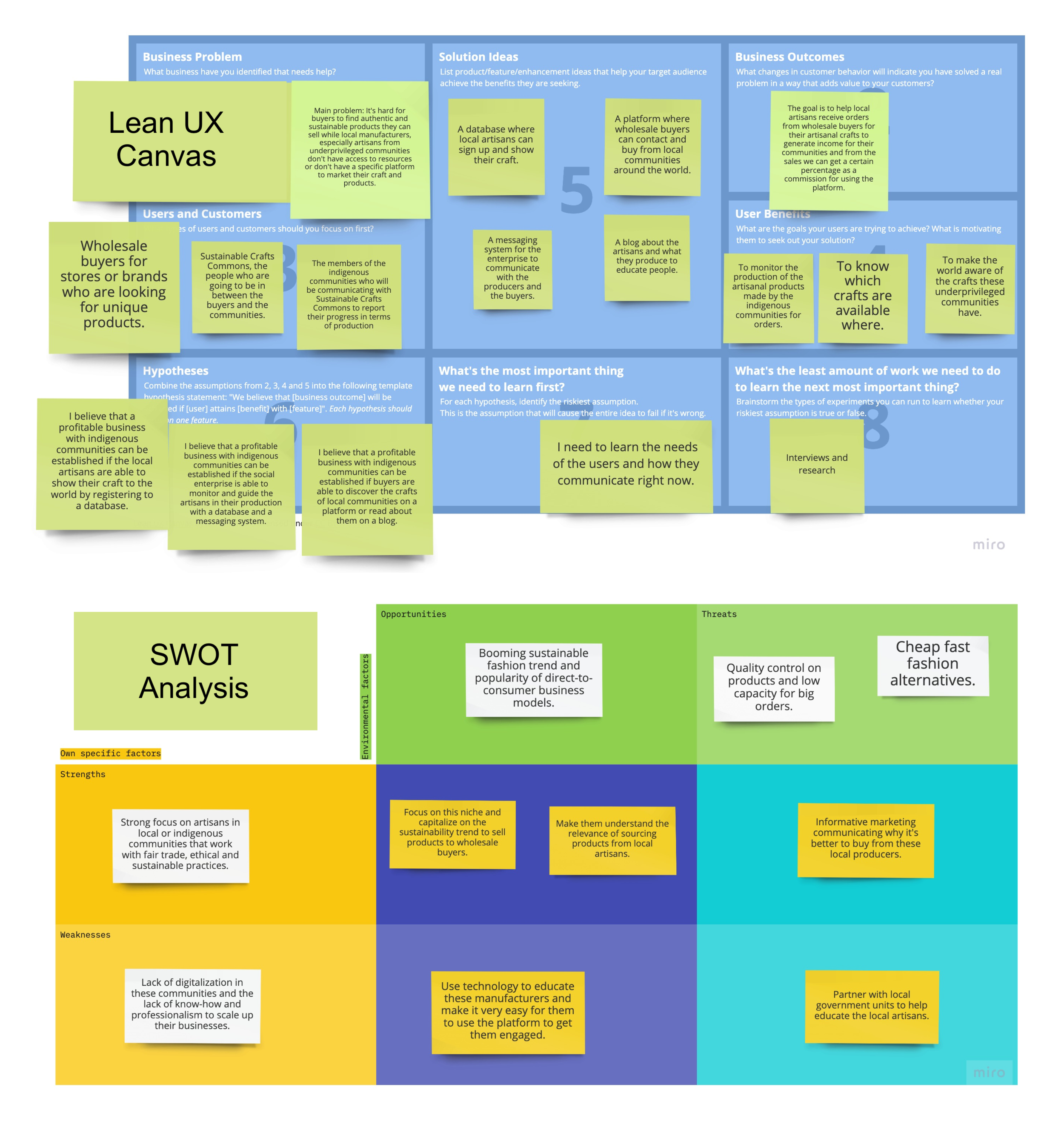Spark Origins
A wholesale and retail e-commerce platform featuring sustainable fashion products ethically made by artisan producers and indigenous communities around the world.
I challenged myself to tackle sustainability in fashion for my final project in my UX/UI design bootcamp at Ironhack Madrid. It was an individual project and I had two weeks to work on it, one week was spent for UX design and the other week for UI.
The problem
As a society we purchase 400% more clothing today than we did just 20 years ago and a lot of it ends up in landfills. Fast fashion is not only destroying our environment but it’s also killing the traditional textile industries around the world. Cultures are quickly disappearing with the trend of people leaving their traditional textile craft.
Retail fashion buyers, who are the ones who decide which products are sold in stores are slowly turning to ethically-made products as consumers are adapting more sustainable lifestyles. I interviewed people who work in the fashion industry and have their own stores or brands and most of them told me that they do want to source their products from local and traditional artisans to be more sustainable, but it’s not very easy especially for smaller businesses.
It’s currently difficult for retail fashion buyers to find suppliers to source sustainable artisan-made merchandise from.
The users
The principal users of the platform are fashion retail buyers for brands or stores that want to sell sustainable or ethically-made products to consumers. A lot of conscious brands these days want to be socially responsible and make sure that the products they sell were produced ethically.
What is a retail buyer?
A retail buyer is responsible for planning, selecting and purchasing quantities of merchandise that are sold in retail stores. They source new merchandise and review their existing lines to ensure their products remain competitive.
The solution
Spark Origins is a wholesale and retail e-commerce platform in the form of a responsive website. It features sustainable and ethically-produced fashion products made by artisan communities around the world.
Retail buyers looking to buy in bulk or wholesale for their own brands or stores can gain access to producers of fashion products that are ethically-made by artisans from indigenous tribes or other marginalized groups.
The process
As always, I used the design thinking method to tackle the problem. The first step is to empathize with the users and do some research.
When I first started working on the project I was deep in the so-called design squiggle. I originally had a different problem to work on related to sustainability in fashion so I started interviewing people I know in the fashion industry. A fashion designer friend of mine who now works in a social enterprise that helps indigenous artisan communities inspired me to change course and focus on this problem.
But I wasn’t sure which user to focus on. Instead of focusing on the end-consumer who buys things from stores for their personal use, I finally decided to focus on some of the people I had already interviewed who are retail buyers or the ones who buy wholesale to sell in stores.
Research
I created a Lean UX Canvas and did a SWOT analysis as a first step to fully understand where I’m going and how I’m going to help the business side or the artisan producers in this case.
I also did some research and found numerous reports and surveys regarding sustainability in fashion where consumer insights show the high demand for sustainable and ethically-made products.
“92% of consumers around the world say they are trying to live more sustainably. 54% say they could be doing more - but they need help.”
— Sustainable brands in partnership with Harris Poll: The Good Life Report, 2017
“62% of consumers agreed that brands should be doing more to promote clothing made in sustainable ways. 52% demand for fair pay for workers in the fashion industry.”
— Nosto Consumer Survey: Sustainability in Fashion Retail, 2019
Interviews
I conducted user interviews and spoke to a total of five fashion business owners who buy wholesale.
80% of the users interviewed mainly use Google and social media networks to look for products and suppliers.
60% say it’s difficult to find suitable suppliers and that they need to do a lot of research and calls before they find what they’re looking for.
“It’s really hard to find sustainable suppliers who can produce what we want and have lower minimum quantity requirements.”
— Ana, small fashion retail business owner
The main problem I focused on is helping retail buyers easily find sustainable suppliers of ethically-made products that they can stock their stores with. The goal is to connect the buyers to the traditional artisan communities. The artisan producers need a platform where they can market their products and get as much exposure to potential buyers and customers as possible. Likewise, buyers need as many options as possible.
During the interviews, sites like Alibaba (a B2B or business to business platform) and Etsy were mentioned for sourcing products. Etsy, despite being primarily a B2C platform (business to consumer) has artisan sellers who also offer their items for wholesale purchase.
After doing a more in-depth competitive analysis I saw that most platforms are either only B2B or B2C. But as I’ve seen with Etsy where smaller, artisanal producers sell their products, it’s possible to have a platform where both wholesale and retail are possible. Therefore I decided to make the platform I’m developing B2ALL, meaning sellers can deal with fashion retail buyers buying wholesale for a store or their own brands to sell, or to an end-consumer who is buying for their own personal use.
User persona
I based the user persona I created on the various people I had interviewed. My user persona’s name is Tina and she’s an independent fashion designer and sustainable fashion boutique owner based in London.
User journey
The user journey I mapped out takes place during Tina’s search for a supplier for a line of bags she’s designing. She’s disappointed when she found one she liked online through Google but they did not get back to her.
I then moved on to the ideation phase after analyzing all the information I had and compiling all the key pieces of information in an affinity diagram. Using HMW I asked the question: How might we make an e-commerce website useful for someone buying wholesale for a brand?
This is when the idea of doing a B2ALL platform came about. Why limit who can buy on the platform? Opening the platform to all types of buyers will only be beneficial for everyone, especially for small business owners who want to buy lower quantities like our user persona Tina.
I did some rounds of brainstorming with the help of my classmates, after which I used the MoSCoW method to prioritize which ideas to include in my MVP.
The next part was one of the most challenging parts for me which is building the information architecture of the platform. I did card sorting with five users and created a site map. What helped me a lot is reviewing some big fashion e-commerce websites out there and seeing how they arrange their products in categories and how they’re presented on their websites. E-commerce platforms are pretty standard these days so I had to make sure I reviewed all the basics.
Key features
Option to buy a sample of a product before committing to a big order
Direct contact with the brands and suppliers through a messaging feature
The evolution from the first paper prototype until the high-fidelity prototype is seen below with the product page as an example. I was honestly quite overwhelmed with this part of the project as there is a lot of information that needed to be on the page but I powered through with a lot of help from the feedback I received during user testings and a lot of research.
Low-fidelity
Mid-fidelity
High-fidelity
Usability testing
Tasks:
Sign up, add a fanny pack sample to the shopping cart and send a message to its supplier
Low-fidelity test (5 users)
100% of the users were able to complete all of the tasks
Main feedback was that there were too many buttons on the product page
Mid-fidelity test (5 users)
100% of the users were able to complete all of the tasks
Some users noted that the color of a product should be included on the product page as a drop-down in case there are other color variations
Branding
The name Spark Origins means impulsing new beginnings. If more people buy the artisans’ products, they can build profitable businesses and help their communities.
To highlight the products I used a minimalist black and white palette with some muted accent colors.
Next steps
Work on the feedback collected from the tests and streamline/simplify the product pages
Verification process of suppliers’ sustainability standards and certifications
Purchase order management tools for B2B users
Mobile application
Learnings
Designing an e-commerce platform from scratch was quite a challenge for me. I did not anticipate the huge amount of detail it entails. I had to pay attention to all the standard features and components of an online store that people automatically expect and also think about the important parts of the B2B aspect of the platform. In hindsight, creating a B2B AND B2C website all in one go might not have been the best idea for an MVP. This taught me a very important lesson in prioritizing.





















